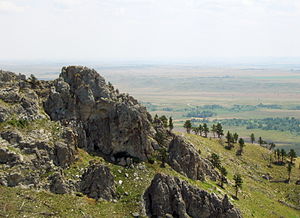 Image via WikipediaThe Sicangu Oyate or Burnt-Thigh people are one of the bands of the Oceti Sakowin (Seven Council Fires) that comprise the Tetuwan Oyate, Lakota or Great Sioux Nation. The name supposedly comes from a time when the band had to run through a fire on the prairie which left many tribal members with burns.
Image via WikipediaThe Sicangu Oyate or Burnt-Thigh people are one of the bands of the Oceti Sakowin (Seven Council Fires) that comprise the Tetuwan Oyate, Lakota or Great Sioux Nation. The name supposedly comes from a time when the band had to run through a fire on the prairie which left many tribal members with burns.Lewis and Clark called them the Teton of the Burnt Woods in their journals of 1804, and said they "rove on both sides of the Missouri, White, and Teton rivers." The French trappers and traders thereafter called them the Upper Brule.
Want to learn more? Read on here

































